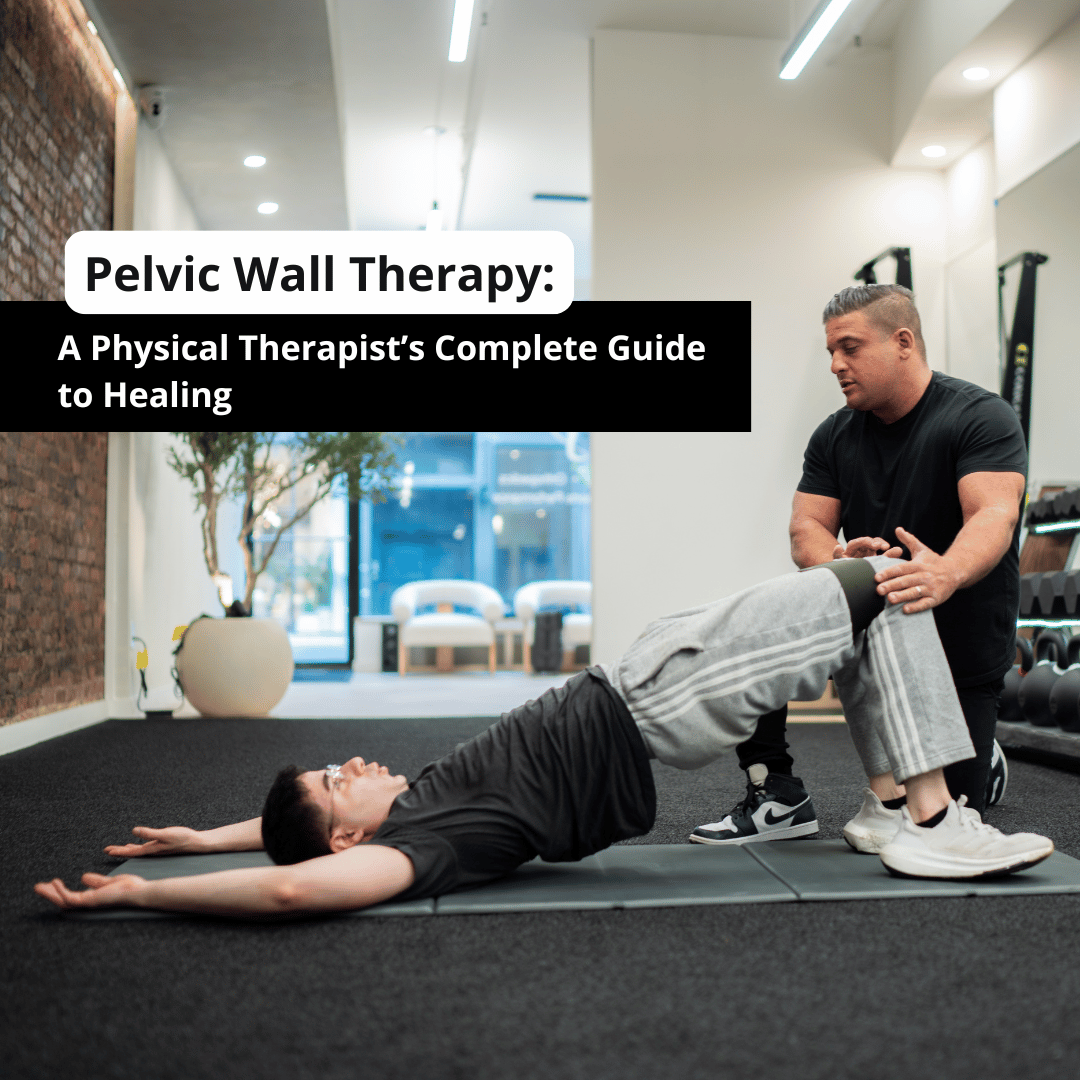Pelvic wall therapy, more commonly referred to as pelvic floor physical therapy (PFPT), is gaining traction as a transformative approach to managing a wide range of pelvic health issues. Despite the growing attention, confusion still exists about what pelvic wall therapy entails, who it’s for, and why it’s a first-line treatment backed by research and medical professionals alike.
As a Doctor of Physical Therapy specializing in pelvic health, I’ve seen the profound impact that this form of therapy can have. This guide will walk you through everything you need to know about pelvic wall therapy.
What Is Pelvic Floor Therapy?
Pelvic floor therapy is a subset of physical therapy that focuses on treating conditions caused by dysfunction of the pelvic floor muscles. The pelvic floor consists of muscles and connective tissue that support the bladder, uterus (or prostate), rectum, and other pelvic organs. These muscles and connective tissue form a hammock-like structure that supports vital internal organs and is attached to the pubic bone and the pelvis, providing stability to the pelvic region.
In women, the pelvic floor also supports the vagina, along with other reproductive organs. Whether the muscles are too weak (hypotonic), too tight (hypertonic), or poorly coordinated, therapy can help retrain them. Dysfunction can involve muscle weakness or muscle spasms, leading to pelvic floor disorder and a range of pelvic floor disorders. These conditions can affect sexual function, and in men, may contribute to erectile dysfunction. This process improves function and alleviates common but often misunderstood.
Pelvic Floor Physical Therapy: How It Works
When people think of pelvic floor physical therapy, Kegels are often the first thing that comes to mind. While Kegels (pelvic floor contractions) can be beneficial for some patients, they are far from a one-size-fits-all solution, and in many cases, they’re not even appropriate, especially for those with pelvic floor overactivity or pain.
Pelvic floor physical therapy is a specialized therapy offering a range of treatment options tailored to each patient. This comprehensive, individualized approach goes far beyond simple exercises. An individualized plan is created based on a thorough assessment to relieve symptoms and reduce pain. The therapy addresses the full complexity of pelvic floor dysfunction by targeting muscular imbalances, nervous system regulation, postural alignment, and behavioral habits that contribute to symptoms. Treatment may include exercise to strengthen pelvic floor muscles, target specific muscles, and train for activities such as heavy lifting. Here’s what that approach often includes:
Internal and External Assessments
During the first appointment, therapists evaluate pelvic floor muscles through both external (abdomen, hips, back) and internal (vaginal or rectal) exams, and an internal exam may be performed as part of the assessment to check muscle tone, strength, and coordination. This helps identify tightness, weakness, prolapse, or scar tissue that may be contributing to symptoms.
Based on assessment findings and patient comfort, both internal and external therapy options are considered to create a comprehensive treatment plan.
Manual Therapy
Hands-on techniques—like myofascial release, trigger point therapy, and scar tissue mobilization—are used to relieve pain, improve circulation, and restore normal muscle function. These may be applied internally or externally. External therapy, including joint mobilization, may be used to address issues in the sacroiliac joint and other areas to improve mobility and support pelvic health.
Biofeedback
This technology uses special sensors attached to the body to monitor the activity of specific pelvic floor muscles. The results are displayed in real time on a computer screen, giving patients immediate feedback on how their pelvic floor muscles are functioning. This helps them learn how to properly contract and relax these muscles. It’s particularly effective for retraining coordination and improving control.
Neuromuscular Reeducation
Therapists help retrain how the pelvic floor works with the core, diaphragm, and posture. This often involves movement-based exercises that integrate breathing, lifting, and stability training for better overall control.
Tailored Pelvic Floor Exercises
Rather than one-size-fits-all Kegels, therapists prescribe tailored pelvic floor exercises that may include Kegel exercises and relaxation techniques, depending on whether the muscles are tight, weak, or poorly coordinated. These can include strengthening, relaxation, or endurance work depending on your goals.
Behavioral Coaching
Simple lifestyle changes—like improving posture, toilet habits, or breathing patterns—can have a major impact. Therapists guide patients on daily routines that reduce strain on the pelvic floor and support healing.
Collaborative Care
When needed, pelvic health therapists work alongside urologists, gynecologists, and other specialists to ensure comprehensive care, especially for complex conditions like interstitial cystitis or chronic pelvic pain.
Recognizing the Symptoms of Pelvic Floor Dysfunction
Many people live with pelvic floor dysfunction without even realizing it. Symptoms can vary based on whether the muscles are too tight or too weak. Common symptoms include:
- Urinary incontinence (leakage during sneezing, laughing, or running)
- Overactive bladder (frequent, urgent need to urinate)
- Pelvic organ prolapse (a sensation of bulging or heaviness)
- Chronic pelvic pain
- Pain during intercourse or gynecological exams
- Constipation or straining during bowel movements
- Low back, hip, or tailbone pain with no clear orthopedic cause
If you’re experiencing one or more of these symptoms, pelvic wall therapy may help relieve symptoms and improve your quality of life.
Why Physical Therapy Is the First Line of Treatment
For those experiencing pelvic floor issues, physical therapy is often recommended before surgical or pharmaceutical interventions. Physical therapists play a crucial role in providing expert care, assessing each patient’s needs, and guiding them through a range of treatment options tailored to their condition. It’s a low-risk, high-reward strategy that’s supported by extensive research.
A 2024 review published in Frontiers in Global Women’s Health highlighted that pelvic floor physical therapy is significantly effective in treating pelvic floor dysfunction—including urinary incontinence, pelvic pain, and sexual dysfunction—without adverse side effects.
Unlike medications that mask symptoms, physical therapy addresses the root cause: the muscle imbalance or coordination dysfunction at the heart of the issue.
How We Treat Pelvic Floor Dysfunction in Clinical Practice
As a pelvic health physical therapist, I assess not only the pelvic muscles themselves, but also the surrounding structures that influence function. Each patient receives an individualized plan based on their specific pelvic floor disorder, taking into account their medical history, examination findings, and personal goals. Treatment plans typically include:
- Manual therapy for trigger points and soft tissue tension
- Postural correction and diaphragmatic breathing
- Pelvic floor exercises that focus on both strength and relaxation, addressing muscle weakness as well as tightness
- Scar tissue mobilization (postpartum or post-surgical)
- Biofeedback and electrical stimulation as needed
- Internal therapy for appropriate cases, when the patient is comfortable
- Education on bladder and bowel behavior modification
Each treatment plan is customized. For example, some patients need to learn how to relax the pelvic muscles—not tighten them—especially those with chronic pain or interstitial cystitis.
Pelvic Floor Exercises: More Than Just Kegels
Pelvic floor exercises are foundational in therapy, but they must be done correctly and under the right circumstances. Not everyone should do Kegels. For individuals with overactive (tight) pelvic muscles, relaxation exercises and down-training are more appropriate.
Examples of common exercises include:
- Slow and fast Kegels (for strengthening, when appropriate)
- Deep core and gluteal activation
- Bridge and squat progressions
- Child’s pose breathing and pelvic drop stretches
Your therapist will evaluate your baseline and recommend exercises that meet your body’s specific needs.
Managing Chronic Pelvic Pain and Interstitial Cystitis with Therapy
Interstitial cystitis (IC), also known as painful bladder syndrome, is a chronic condition characterized by bladder pressure, pain, and frequent urination. While the exact cause is unknown, pelvic floor dysfunction is a common underlying factor, and IC is considered one of several pelvic floor disorders that can be addressed with therapy.
Research shows that physical therapy focusing on myofascial release and trigger point therapy can significantly reduce symptoms in people with IC. Internal therapy, such as internal vaginal or rectal release techniques, is often included in the treatment plan—alongside behavior changes and bladder retraining. The goal of therapy is to relieve symptoms and reduce pain, improving overall quality of life.
Patients with IC often respond best to a multidisciplinary approach involving PT, dietary changes, and pain psychology.
When Should You Start Pelvic Floor Therapy?
Early intervention is ideal. However, it’s never too late to seek help. You should consider seeing a pelvic health physical therapist if you:
- Experience urinary or bowel leakage
- Have pelvic pressure or notice a bulge
- Feel pain with sex or during pelvic exams
- Suffer from chronic pelvic or lower back pain
- Are recovering from childbirth, abdominal surgery, or pelvic trauma
Postpartum recovery is especially critical. Studies show that initiating pelvic floor therapy within the first 6–12 weeks postpartum can prevent long-term issues such as prolapse, diastasis recti, and bladder dysfunction.
What Does a Pelvic Therapy Session Look Like?
A typical pelvic floor physical therapy session may include:
- Review of symptoms and daily habits
- Reassessment of posture, breathing, and muscle tone
- Guided pelvic floor exercises or manual therapy, including internal and external therapy as appropriate
- Education on self-care tools (perineal massage, dilators, postural changes)
- Progress tracking and goal-setting
Therapy is typically done once per week for 6 to 10 weeks, depending on your condition and response to treatment.
Conclusion: Take the First Step Toward Pelvic Health
Pelvic wall therapy is a safe, effective, evidence-based path to healing pelvic floor dysfunction. Whether you’re a new mom, recovering from surgery, or managing chronic pain or interstitial cystitis, pelvic floor physical therapy offers real hope without relying on medications or surgery.
As a PT, I’ve seen how profoundly this therapy can change lives. Don’t wait for symptoms to worsen. With tailored guidance, pelvic floor rehabilitation can restore function, reduce pain, and help you reclaim control over your body.
Ready to take the first step? Visit Pelvis NYC to schedule an evaluation with a specialized pelvic health therapist and start your journey to recovery.


